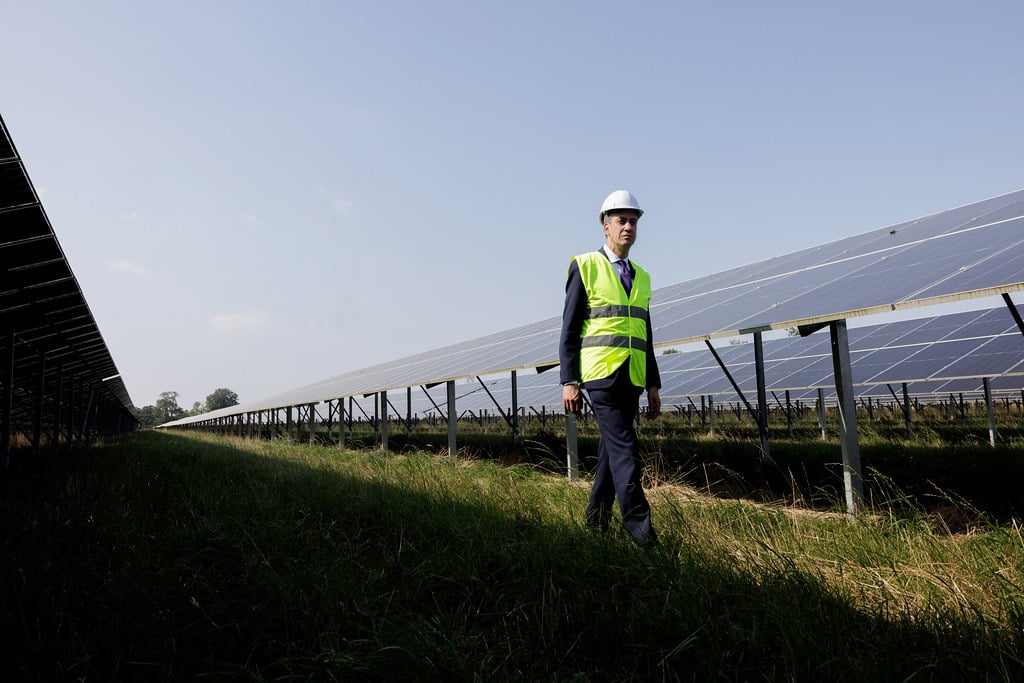
The UK government has today published its Solar Roadmap, a government-industry paper setting out practical measures to meet solar capacity targets.
The roadmap states that meeting the upper end of the capacity ambition set in the Clean Power 2030 (CP30) Action Plan of 47GW solar installed would require just 0.4% of total UK land and power the equivalent of nine million homes using solar energy.
It is the culmination of two years’ work, with the Solar Taskforce launched per the recommendation of ex-Conservative member of parliament Chris Skidmore in his 2023 Review of Net Zero, and reconvened by current energy secretary Ed Miliband shortly after the current government came to power.
In its current iteration, the taskforce has been co-chaired by Miliband and chief executive of solar trade body Solar Energy UK (SEUK) Chris Hewett. It was previously chaired by Andrew Bowie MP and Graham Stuart MP.
The Solar Roadmap sets 72 actions for accelerating the efficient rollout of solar across the UK, divided into six categories: Rooftop Solar, Electricity Networks, Supply Chain and Innovations, Skills, Planning and support schemes, and Working with others.
The taskforce will now become the Solar Council, co-chaired by Hewett and energy minister Michael Shanks to oversee progress and identify and address emerging threat as and opportunities as they arise.
Key actions in the roadmap include procedural reforms to work parallel to the existing grid connection reforms that would speed grid connections, allowing large-scale rooftop and groundmount projects most likely to go ahead to jump the queue.
After its initial investment in schools and NHS buildings, GB Energy is highlighted by the roadmap as a key tool for supporting the rollout of rooftop PV in the public sector. For private commercial buildings, the National Wealth Fund (NWF) will explore potential structures to finance solar projects or portfolios, pursuing innovative business models, including those entering into PPAs with sub-investment grade counterparties.
The taskforce identified an ongoing lack of awareness as to the benefits of both domestic and commercial-scale rooftop PV as an obstacle to meeting targets. So, the government will update its Energy Efficient Home website to promote solar deployment, and the UK Warehousing Association will develop a toolkit for the commercial market. It will also work to resolve barriers such as leasing terms and network connection difficulties.
One of the roadmap actions will see an investigation into the safety of ‘plug-in panels’, which have been seen deployed on balconies across Spain and Germany. The technology is currently banned in the UK but theoretically makes it easier and cheaper to deploy domestic solar by installing panels that plug in to the home’s plug sockets.
UK solar supply chain
According to the government, the Solar Roadmap represents a “once-in-a-generation opportunity to grow the solar supply chain and manufacturing capacity in the UK.”
Conventional silicon-based panel manufacturing is concentrated in China, something that has been acknowledged and unchallenged in the solar sector for some time. While establishing domestic silicon panel manufacturing is not economically viable, the roadmap says there is scope to grow the production of transformers, inverters, switchgear, supporting bracketry, battery storage, and cabling.
There is also an opportunity for lightweight perovskite technology and R&D in the UK, with the thin-film technology developed by Power Roll cited as an example.
Neil Spann, CEO of Power Roll, said that to fulfil the ambition set out in the roadmap of tripling solar deployment in the UK, solutions for the one-in-four commercial rooftops that cannot support traditional solar PV panels will be needed.
“We are pleased to have been featured in the UK Solar Taskforce report published this morning, which recognises that our leading, innovative solar film has the potential to revolutionise global energy solutions,” he said.
The roadmap commits the government to explore opportunities to support the development of standards for next generation solar panels and emerging applications.
The roadmap also sets out support for the Solar Stewardship Initiative to ensure that no solar panels are procured from supply chains that stem from forced labour; the Great British Energy company’s commitment to slavery-free solar also uses the initiative, set up by SEUK.
In building a workforce that can support the UK’s solar growth, the roadmap offers 11 actions on skills, including improving training and mapping routes to competence.
Training for planning departments will also be provided which, along with reforms to the planning system, should speed approvals for large-scale solar developments. Another notable action from the roadmap will see the government address the viability of including floating solar PV in the Contracts for Difference (CfD) mechanism to provide for income security for the emerging technology.
The new Solar Council will meet three times a year to assess progress on each of the action points and ensure the UK is on track to meet solar deployment targets.

